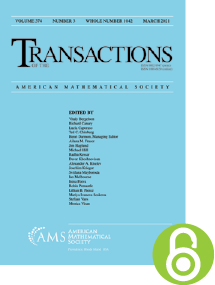About boundary values in $A(\Omega )$
HTML articles powered by AMS MathViewer
- by Piotr Kot PDF
- Trans. Amer. Math. Soc. 363 (2011), 4063-4079 Request permission
Abstract:
Assume that $\Omega \subset \mathbb C^{n}$ is a balanced bounded domain with a holomorphic support function (e.g. strictly pseudoconvex domain with $C^{2}$ boundary). We denote $\left \Vert f\right \Vert _{z}^{2}:=\int _{0}^{1}|f(e^{2\pi it}z)|^{2}dt$. Let $\varepsilon >0$ and $\sigma$ be a circular invariant Borel probability measure on $\partial \Omega$. If $g\in A(\Omega )$ and $h$ is a continuous function on $\partial \Omega$ with $|g|<h$ on $\partial \Omega$, then we construct nonconstant functions $f_{1},f_{2}\in A(\Omega )$ with $\left \Vert g+f_{1}\right \Vert _{z}\leq \left \Vert h\right \Vert _{z}$, $|(g+f_{2})(z)|\leq \max _{|\lambda |=1}h(\lambda z)$ for $z\in \partial \Omega$ and \[ \sigma \left (\left \{ z\in \partial \Omega :\left \Vert g+f_{1}\right \Vert _{z}\ne \left \Vert h\right \Vert _{z}\vee \max _{|\lambda |=1}|(g+f_{2})(\lambda z)| \ne \max _{|\lambda |=1}h(\lambda z)\right \} \right )<\varepsilon .\]
Additionally if $\Omega$ is a circular, bounded, strictly convex domain with $C^{2}$ boundary, then we give the construction of $f_{3}\in \mathbb O(\Omega )$, the holomorphic function with: $\left \Vert h-|g+f_{3}^{*}|\right \Vert _{z}=0$ for all $z\in \partial \Omega$, where $f^{*}$ denotes the radial limit of $f$. We also construct $f_{4}\in A(\Omega )$ with $\left \Vert g+f_{4}\right \Vert _{z}=\left \Vert h\right \Vert _{z}$ for $z\in \partial \Omega$.
In all cases we can make $f_{i}$ arbitrarily small on a given compact subset $F\subset \Omega$ and make it vanish to a given order at the point $0$.
References
- A. B. Aleksandrov, The existence of inner functions in a ball, Mat. Sb. (N.S.) 118(160) (1982), no. 2, 147–163, 287 (Russian). MR 658785
- Piotr Kot, A holomorphic function with given almost all boundary values on a domain with holomorphic support function, J. Convex Anal. 14 (2007), no. 4, 693–704. MR 2350811
- Piotr Kot, Homogeneous polynomials on strictly convex domains, Proc. Amer. Math. Soc. 135 (2007), no. 12, 3895–3903. MR 2341939, DOI 10.1090/S0002-9939-07-08939-3
- Piotr Kot, Bounded holomorphic functions with given maximum modulus on all circles, Proc. Amer. Math. Soc. 137 (2009), no. 1, 179–187. MR 2439439, DOI 10.1090/S0002-9939-08-09468-9
- Erik Løw, Inner functions and boundary values in $H^{\infty }(\Omega )$ and $A(\Omega )$ in smoothly bounded pseudoconvex domains, Math. Z. 185 (1984), no. 2, 191–210. MR 731340, DOI 10.1007/BF01181690
- Berit Stensønes Henriksen, A peak set of Hausdorff dimension $2n-1$ for the algebra $A({\cal D})$ in the boundary of a domain ${\cal D}$ with $C^{\infty }$-boundary in $\textbf {C}^{n}$, Math. Ann. 259 (1982), no. 2, 271–277. MR 656666, DOI 10.1007/BF01457313
- Th. Duchamp and E. L. Stout, Maximum modulus sets, Ann. Inst. Fourier (Grenoble) 31 (1981), no. 3, v, 37–69 (English, with French summary). MR 638616
- Edgar Lee Stout, The dimension of peak-interpolation sets, Proc. Amer. Math. Soc. 86 (1982), no. 3, 413–416. MR 671206, DOI 10.1090/S0002-9939-1982-0671206-0
Additional Information
- Piotr Kot
- Affiliation: Instytut Matematyki, Politechnika Krakowska, ul. Warszawska 24, 31-155 Kraków, Poland
- Email: pkot@pk.edu.pl
- Received by editor(s): December 16, 2007
- Received by editor(s) in revised form: April 13, 2009
- Published electronically: March 21, 2011
- © Copyright 2011 American Mathematical Society
- Journal: Trans. Amer. Math. Soc. 363 (2011), 4063-4079
- MSC (2010): Primary 32A05, 32A40
- DOI: https://doi.org/10.1090/S0002-9947-2011-05083-X
- MathSciNet review: 2792980


